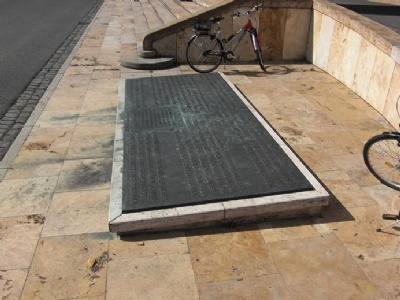Frankfurt - IG Farben
IG Farben is an abbreviation of Interessen-Gemeinschaft Farbeindustrie AG and was a chemical company with its headquarters in Frankfurt am Main. The company was founded in 1925 and was in 1928 Europe’s fourth largest company. The company had several Jews in leading postions which of course was heavily disapproved by the Nazis. But both were well aware that mutual cooperation would be in both interest. Farben specialized in producing synthetic fuel and rubber, which was important for the Nazis’ plans to prepare Germany for a future war.
Farben’s close cooperation with the Nazis gave the company the opportunity to acquire similar companies or companies that could be used for chemical production in the occupied countries. A large factory complex (Buna-Werke) was established in Auschwitz in 1941 for the production of synthetic rubber. The reason the factory was located in Auschwitz was the possibility of hiring cheap labour from the nearby concentration camps Auschwitz I and Auschwitz II – Birkenau. The great need for manpower in the factory was reason enough for the Germans to set up a third Auschwitz camp near the factory, called Auschwitz III – Monowitz.
IG Farben held a large share (42.5 percent) in a company called DEGESCH (Deutsche Gesellschaft für Schedulingskampfung, the German company for the control of vermin). DEGESCH was founded in 1919 by a company called Degussa, which had an equal shareholding in DEGESCH as IG Farben. DEGESCH produced Zyklon B (hydrogen cyanide gas, HCN) gas, which was produced to control vermin such as lice and rats, which was then sold through the company Tesch und Stabenow from Hamburg to, among others, the German army and later also the SS who used the gas to disinfect barracks in its camps...........and to murder Jews.
Current status: Preserved with monument (2011).
Address: Grüneburgplatz 1, 60323 Frankfurt am Main.
Get there: Metro to Holzhausenstrasse Station.
Follow up in books: Borkin, Joseph: Hitler & IG Farben (1978).


In 1947, 22 directors and other leaders of IG Farben were brought to justice in Nuremberg on charges of war preparations, crimes against peace and crimes against humanity. 13 Of the accused were sentenced to prison terms between 18 months and six years. After the war, IG Farben had trouble continuing its operations, the company was confiscated by the victory powers who dismembered it. The industries belonging to IG Farben in what became Eastern Europe were nationalized by the communist regimes. In 1952, the company was closed down, but that did not mean that it ceased to exist as a legal entity but continued to exist as a corporation. In 2011, it was still possible to trade in shares belonging to IG Farben and in Western Europe parts of the company were sold to stakeholders. In 2011, there were three companies originating in IG Farben. The claims for damages to former slave workers who were hired by the SS to IG Farben is a process in itself where it seems today to be difficult to determine who should pay what. In 2011, Johann Wolfgang Göthe University is located in the building.
IG Farben’s cooperation with the Nazis is a clear example of how an industry puts itself at the disposal of politics. IG Farben understood that with the Nazis in power, there were opportunities for geographical expansion, economic influence and technological development at a time when Germany regained its place as a European superpower. They did so out of free will and not out of any kind of threat and their knowledge helped to build up the German armed forces even if it meant the exploitation of slave workers. If IG Farben refused to cooperate with the Nazis, the consequence would have been that the Nazis had turned to other companies and the risk would have been that IG Farben lost its position as a market leader in chemical industrial. Such an opportunity was just not to be missed and any ideological differences were put aside. But even the Nazis understood the importance of having IG Farben’s knowledge at their disposal and were prepared for concessions if it served their own purposes.